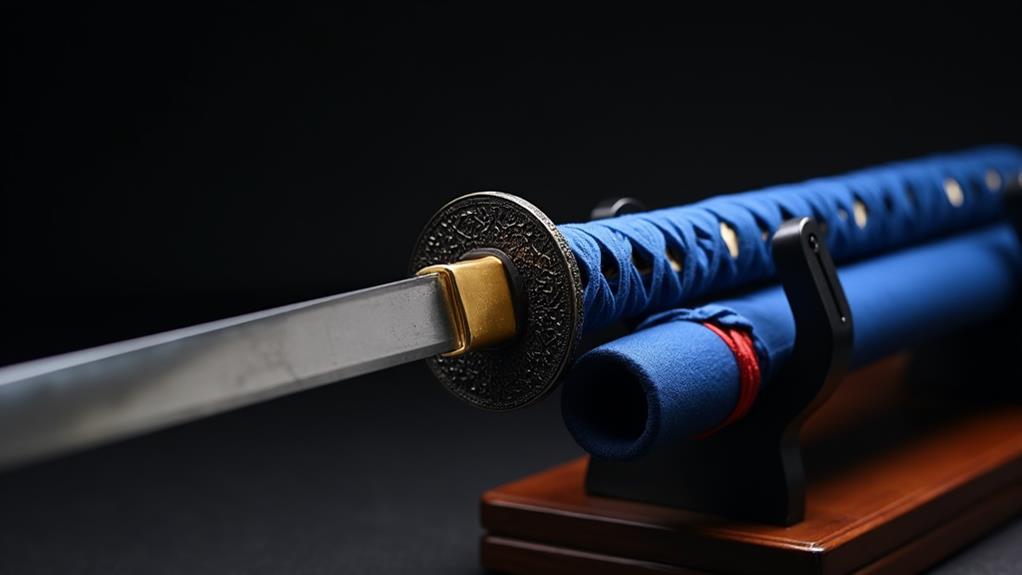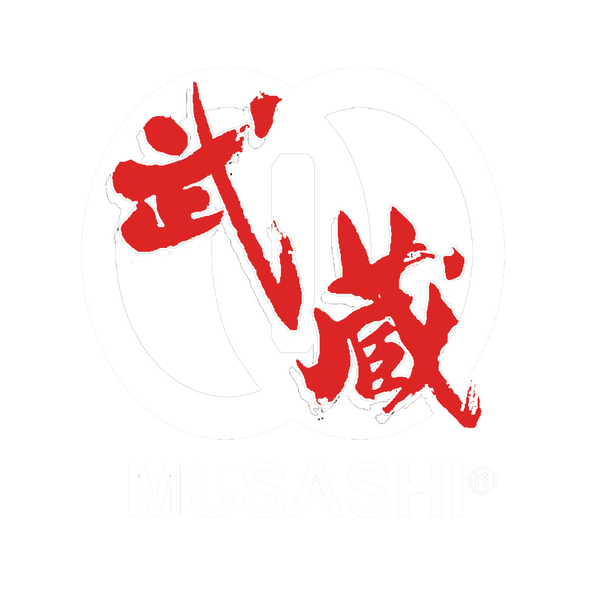
Blue katanas blend traditional Japanese swordsmithing with modern design, creating a unique aesthetic. These swords maintain the functionality and cultural significance of traditional katanas while incorporating innovative elements. The blue hue is achieved through specialized heat treatment or coatings, symbolizing progress and innovation. Craftsmen combine time-honored techniques with contemporary manufacturing methods to produce these striking weapons. Blue katanas appeal to martial artists for training and collectors who appreciate the fusion of historical craftsmanship and artistic expression. They represent a bridge between Japan's rich sword-making heritage and modern artistic sensibilities. Exploring this topic further reveals fascinating insights into the evolution of sword design and cultural symbolism.
Key Takeaways
- Blue katanas combine traditional Japanese swordsmithing techniques with contemporary design elements and color treatments.
- The blue hue is achieved through specialized heat treatments or coatings, symbolizing innovation and progress.
- These swords maintain the functionality of traditional katanas while offering a visually distinct aesthetic for martial arts practice.
- Blue katanas represent a fusion of Japanese cultural heritage with modern artistic expression and craftsmanship.
- Collectors value blue katanas for their rarity, growing market appeal, and unique blend of historical authenticity and contemporary design.
The Origin of Blue Katanas
Blue katanas, a striking fusion of traditional Japanese swordsmithing and contemporary design, emerged in the late 20th century. These unique weapons combine the time-honored craftsmanship of katana-making with modern aesthetics and materials, reflecting the ideals of honor and loyalty espoused by Japanese culture. The blue hue is achieved through various techniques, including heat treatment of the steel or the application of specialized coatings. Swords represent the ideals of honor while encapsulating the samurai spirit that has captivated many.

While traditional practices remain at the core of blue katana production, artisans have embraced innovative methods to create these distinctive blades. The use of unique materials, such as titanium alloys or high-carbon steels, allows for both visual appeal and enhanced performance. Some makers incorporate traditional Japanese patterns and engravings into the blue steel, further blending old and new.
The origin of blue katanas reflects a desire to preserve the essence of Japanese sword-making while adapting to changing tastes and technological advancements.
Craftsmanship and Manufacturing Techniques
Crafting a blue katana calls for a blend of traditional Japanese swordsmithing techniques and modern manufacturing methods. This unique fusion of technology and artistry results in swords that not only meet performance expectations but also capture the spirit of craftsmanship, reminiscent of hand-made swords' unique features.
The process combines innovative forging methods with time-honored blade heat treatment techniques to create a unique and visually striking weapon.
Skilled artisans employ cutting-edge technology alongside ancient practices to produce blue katanas that satisfy exacting standards. The key steps in the manufacturing process include:
- Selecting high-quality steel alloys
- Precision forging and shaping
- Applying specialized blue coatings
- Implementing advanced heat treatment techniques
- Rigorous quality control and testing
These steps guarantee that each blue katana maintains the legendary strength and sharpness associated with traditional Japanese swords while incorporating modern aesthetics. The result is a masterpiece that balances form and function, appealing to both collectors and practitioners of martial arts who demand excellence in their bladed weapons.
Symbolism and Cultural Significance
While the craftsmanship of blue katanas represents a fusion of tradition and modernity, their symbolism and cultural significance extend far beyond mere aesthetics. As a cultural representation, blue katanas embody the blending of Japanese heritage with contemporary design sensibilities.
The connection between swords and the ideals of valor and honor further enhances their cultural meaning, reflecting the Cultural and Spiritual Significance of Swords in Japanese history. The striking blue color often symbolizes innovation and progress, while maintaining the revered status of the katana in Japanese culture.
The symbolic meaning of these blue-hued blades can vary, ranging from representations of water and sky to more abstract concepts like wisdom and tranquility. For many collectors and enthusiasts, owning a blue katana signifies an appreciation for both historical craftsmanship and modern artistic expression. These unique swords serve as conversation pieces, bridging the gap between traditional Japanese weaponry and contemporary art forms, while allowing individuals to express their personal style and cultural interests.
Functionality in Martial Arts
Despite their striking appearance, blue katanas hold up with respect to functionality for martial arts practice. These swords maintain the vital characteristics that make katanas effective in combat techniques, embodying virtues of honor and discipline.
The blue coloration does not compromise the blade's strength, sharpness, or balance, ensuring its practical applications remain intact. Martial artists can effectively use blue katanas for:
- Cutting practice (tameshigiri)
- Kata demonstrations
- Sparring exercises
- Edge alignment training
- Drawing and resheathing drills
The functionality of blue katanas extends beyond aesthetics, allowing practitioners to hone their skills with a visually distinct weapon. While traditionalists may prefer classic designs, blue katanas offer a modern alternative without sacrificing performance.
These swords enable martial artists to master traditional techniques while embracing contemporary style, bridging the gap between historical authenticity and personal expression in their training regimen. Additionally, the philosophy of katana wielding emphasizes swordsmanship techniques that promote character development, enhancing the overall training experience.
Collectors' Perspective
From a collector's standpoint, blue katanas offer a unique and eye-catching addition to any sword collection. These modern interpretations of traditional Japanese swords reflect evolving collector preferences, combining historical craftsmanship with contemporary aesthetics. The blue hue, often achieved through various techniques, sets these katanas apart from their conventional counterparts.
| Aspect | Traditional Katanas | Blue Katanas |
|---|---|---|
| Rarity | Common | Rare |
| Appeal | Historical | Modern |
| Value | Established | Growing |
Historical collecting trends have typically favored authentic, traditionally-crafted katanas. However, the emergence of blue katanas has sparked interest among collectors seeking distinctive pieces. These swords appeal to those who appreciate both Japanese sword-making heritage and innovative design. As the market for blue katanas expands, collectors must carefully evaluate factors such as craftsmanship, materials, and overall quality to guarantee they acquire valuable and meaningful additions to their collections.
Future of Colored Sword Design
The rise of blue katanas in collectors' circles signals a broader trend in sword design, pointing towards a colorful future for these traditional weapons. As technology advances, we can expect to see more innovative blade coatings and customizable hilt designs. These developments will allow sword enthusiasts to personalize their weapons while maintaining the essence of traditional craftsmanship.

The future of colored sword design may include:
- Advanced color-changing coatings
- Holographic blade patterns
- Glow-in-the-dark elements
- Laser-etched designs
- Interchangeable colored components
These innovations will give collectors unprecedented control over their sword's appearance. However, it's pivotal to balance modern aesthetics with respect for traditional techniques. As the market evolves, we may see a divide between purists who prefer classical designs and those embracing new color options. Ultimately, the future of colored sword design will likely be a blend of tradition and innovation.
Frequently Asked Questions
Are Blue Katanas Legal to Own and Carry in Different Countries?
The legality of owning and carrying katanas varies by country, with regional restrictions in place. While some nations recognize their cultural significance, others impose strict regulations. Always consult local laws before acquiring or transporting such weapons.
How Does the Blue Coloration Affect the Sword's Durability and Maintenance?
The blue coloration, achieved through specialized blade tempering processes, generally does not impact durability. However, proper coloring preservation techniques are vital for maintaining the aesthetic. Regular care and controlled storage conditions safeguard longevity of both performance and appearance.
Can Blue Katanas Be Used for Cutting Practice or Only Display?
Blue katanas can be used for cutting practice, provided their structural integrity matches traditional blades. However, their cutting effectiveness may vary. Serious practitioners should evaluate each sword individually, considering factors beyond aesthetics when selecting for practical use.
What Price Range Can One Expect for a High-Quality Blue Katana?
High-quality blue katanas typically range from $500 to $3000+, depending on manufacturing techniques and material composition. Prices reflect craftsmanship, steel quality, and finishing processes. Serious collectors should expect to invest considerably for authentic, performance-grade blue katanas.
Are There Any Famous Historical Figures Associated With Blue Katanas?
The historical significance of blue katanas is limited, as they are primarily modern creations. Traditional katanas were not blue. However, blue katanas have gained cultural symbolism in contemporary media, representing uniqueness and artistic expression in martial arts.
Conclusion
Blue katanas represent a fusion of traditional Japanese swordcraft and modern aesthetics. While departing from historical norms, these colorful blades maintain the essence of katana craftsmanship. Their popularity among collectors and martial artists demonstrates a shift in sword appreciation. As colored sword designs evolve, blue katanas serve as a bridge between past and present, challenging conventional notions of authenticity while preserving the core principles of katana making. This trend may influence future innovations in sword design and manufacturing techniques. Musashi Swords is one of the companies at the forefront of this blue katana trend, offering a range of high-quality blue-bladed swords that combine traditional craftsmanship with modern design elements.


